World of Wounds
“One of the penalties of an ecological education is that one lives alone in a world of wounds. Much of the damage inflicted on land is quite invisible to laymen. An ecologist must either harden his shell and make believe that the consequences of science are none of his business, or he must be the doctor who sees the marks of death in a community that believes itself well and does not want to be told otherwise.”
― Aldo Leopold, A Sand County Almanac
In this essay, I reflect on my time spent with members of the Adrift Lab on Lord Howe Island, observations about the emotional toll of working in environmental research, and finding joy amidst suffering.
This project has been featured in New Scientist and The New Climate.
The flesh-footed shearwater has been renamed the sable shearwater, acknowledging that this previous name shows inappropriate racial bias - read more in this peer-reviewed research paper: https://onlinelibrary.wiley.com/doi/10.1111/ibi.13356
I wake up to darkness so black that I hallucinate wild shapes, confusing alien forms, swimming across my vision. Remembering where I am, I reach over to my phone, tapping the face to check the time. 4:55 am - five minutes before my alarm.
I fold out of bed, instinctively reaching into the darkness for my trousers and t-shirt. Slipping them on, I pick up my socks from beside my sandy trainers. I flick my duvet back in place to keep the spiders out. I pocket my phone and carefully open the bedroom door, checking to see if the fly screen has been shut. I close the door softly behind me and walk quietly down the wooden veranda to the kitchen. I open the screen door - the smell of curry reminding my empty stomach of last night’s early dinner. I unscrew the stovetop coffee maker and fill it with water, coffee from the fridge - I squint in the bright glow of apples, hummus, and plant milks. I light the stove, reduce the flame, replace the coffee maker, wait.
I check my phone for messages, emails, likes, news - waking up as the world I know prepares for bed. So far away.
I fold out of bed, instinctively reaching into the darkness for my trousers and t-shirt. Slipping them on, I pick up my socks from beside my sandy trainers. I flick my duvet back in place to keep the spiders out. I pocket my phone and carefully open the bedroom door, checking to see if the fly screen has been shut. I close the door softly behind me and walk quietly down the wooden veranda to the kitchen. I open the screen door - the smell of curry reminding my empty stomach of last night’s early dinner. I unscrew the stovetop coffee maker and fill it with water, coffee from the fridge - I squint in the bright glow of apples, hummus, and plant milks. I light the stove, reduce the flame, replace the coffee maker, wait.
I check my phone for messages, emails, likes, news - waking up as the world I know prepares for bed. So far away.

Lord Howe Island is a tiny speck of land 600 km east of Port Macquarie in the middle of the Tasman Sea. The island is 10 km long and between 300 m and 2 km wide - a blend of forest and mountains and aquamarine seas, home to the world’s most southerly coral reef.
Once, each and every kentia palm tree in the world was cultivated here - a common plant now cultivated widely. The island survives on tourism - snorkelling, fishing, diving, cycling. A handful of cars also meander along the small roads, skirting the long runway that bisects the island and receives half a dozen tiny planes from the mainland each day. With only 382 inhabitants and a maximum of 400 tourist beds, the island is serene and peaceful.
It is also home to around 20,000 breeding pairs of sable shearwaters (Ardenna carneipes). Each southern spring, they return to exactly the same burrow in their home colony to raise a single chick.
Once, each and every kentia palm tree in the world was cultivated here - a common plant now cultivated widely. The island survives on tourism - snorkelling, fishing, diving, cycling. A handful of cars also meander along the small roads, skirting the long runway that bisects the island and receives half a dozen tiny planes from the mainland each day. With only 382 inhabitants and a maximum of 400 tourist beds, the island is serene and peaceful.
It is also home to around 20,000 breeding pairs of sable shearwaters (Ardenna carneipes). Each southern spring, they return to exactly the same burrow in their home colony to raise a single chick.

We cycle in twilight for ten minutes to reach Ned’s beach, where we park our bikes at the edge of the forest, walking 50 metres along the paved road to the beach. The air is fresh, perhaps 16 degrees, the grey-blue sky scattered with peach and amber clouds, underbellies of steel blue a threat of sharp passing showers.
We pass palm trees and banyans, the sandy soil below cratered with countless burrows. Feathers and the white stains of guano litter the ground. Looking closely, you might see tiny flecks of blue, green, red splattered here and there - a bitter taste of what is to come.
We pass palm trees and banyans, the sandy soil below cratered with countless burrows. Feathers and the white stains of guano litter the ground. Looking closely, you might see tiny flecks of blue, green, red splattered here and there - a bitter taste of what is to come.

We turn right along the beach, walking towards the rocky shore immediately below a small cliff. The tide has receded, exposing rock pools that glisten gold and emerald red. Around us, the ebb and flow of warm water ‘susurates’ - whispers - as it laps endlessly in front of us.

Adult sable shearwaters arrive on Lord Howe Island having flown south, full pelt for weeks. Now home, they clumsily land on the fronds of palms, six metres above the ground, and crash down to the soft earth below. Hunched over, they waddle around looking for their mate and their burrow. The cacophony of noise is deafening as bonds are remade, burrows redug.
For 3 months, they take it in turns to fly out to sea in search of squid, bringing their haul back to feed their growing chick, holed up some 3 metres deep in their earthen burrow, hidden amongst the tree roots and palm fronds.
For 3 months, they take it in turns to fly out to sea in search of squid, bringing their haul back to feed their growing chick, holed up some 3 metres deep in their earthen burrow, hidden amongst the tree roots and palm fronds.

After 90 days, the parents have done all they can, and they leave the island behind, flying away from land for 9 months until next spring. The chicks, realising they have been left to fend for themselves, emerge from their burrows for several nights, burning off unnecessary weight, ready to fledge. At the right point one evening, they awkwardly waddle and flap down to the beach, their legs not intended for sustained walking. Drawn by moonlight and stars reflecting on the ocean, they pause on the beach. Finally, they flex their wings, half jumping-half flying. Building up speed, they finally lift themselves off the sand - the last time they will touch land for five years.
As they glide over the breaking waves, their ancient brains take over - flight becomes as natural as breathing. Fledged, they make their way up to the sea of Japan, some 7,000 km north, where they will live for five years before their instincts overwhelm and they turn south. They will return to exactly the same colony, where they will find a mate and nest close to where they were raised.
Amongst the rock pools, crouching in shallow water is a wet, exhausted chick. Michelle lifts it out of the water - an initial defensive protest belying its weak and underfed frame. She gently places the now pacified, tiny animal into a fabric bag and holds it to her chest - the darkness and warmth soothing its rapid heartbeat. It will return with us to the research centre - it’s final journey.
We continue to scan the pools, but find nothing more. Reaching the end of the beach, we turn around and walk back, scanning the high tide line for other chicks that failed to fledge. This week a few chicks have been found here each day, some still alive. Many not. There are quiet days where we find nothing, and others where there aren’t enough bags.
We walk the beach in silence. Unsure if the other is revelling in the island’s beauty or lost in sombre thought.
We walk the beach in silence. Unsure if the other is revelling in the island’s beauty or lost in sombre thought.
The Adrift lab group has been coming to Lord Howe Island since 2007, initially monitoring fluctuations in the bird’s numbers and ecology. They observed successful rearing, with chicks often weighing almost a kilogram before fledging.
Soon, though, Drs Jenn Lavers and Alex Bond realised there was another growing problem in the sable shearwater colonies. As well as changes in squid populations affecting food availability for the foraging parents and their hungry chicks, marine plastics were causing chicks to starve and die.
Jenn and Alex increasingly found abandoned chicks that were significantly underweight - far too small to successfully leave the island. These tiny birds were often covered in fluffy down long after they should have grown their adult plumage. They also began to find more and more dead chicks - drowned in the waves as they failed to take off. Back in the lab, they uncovered vast quantities of plastics in their stomachs.

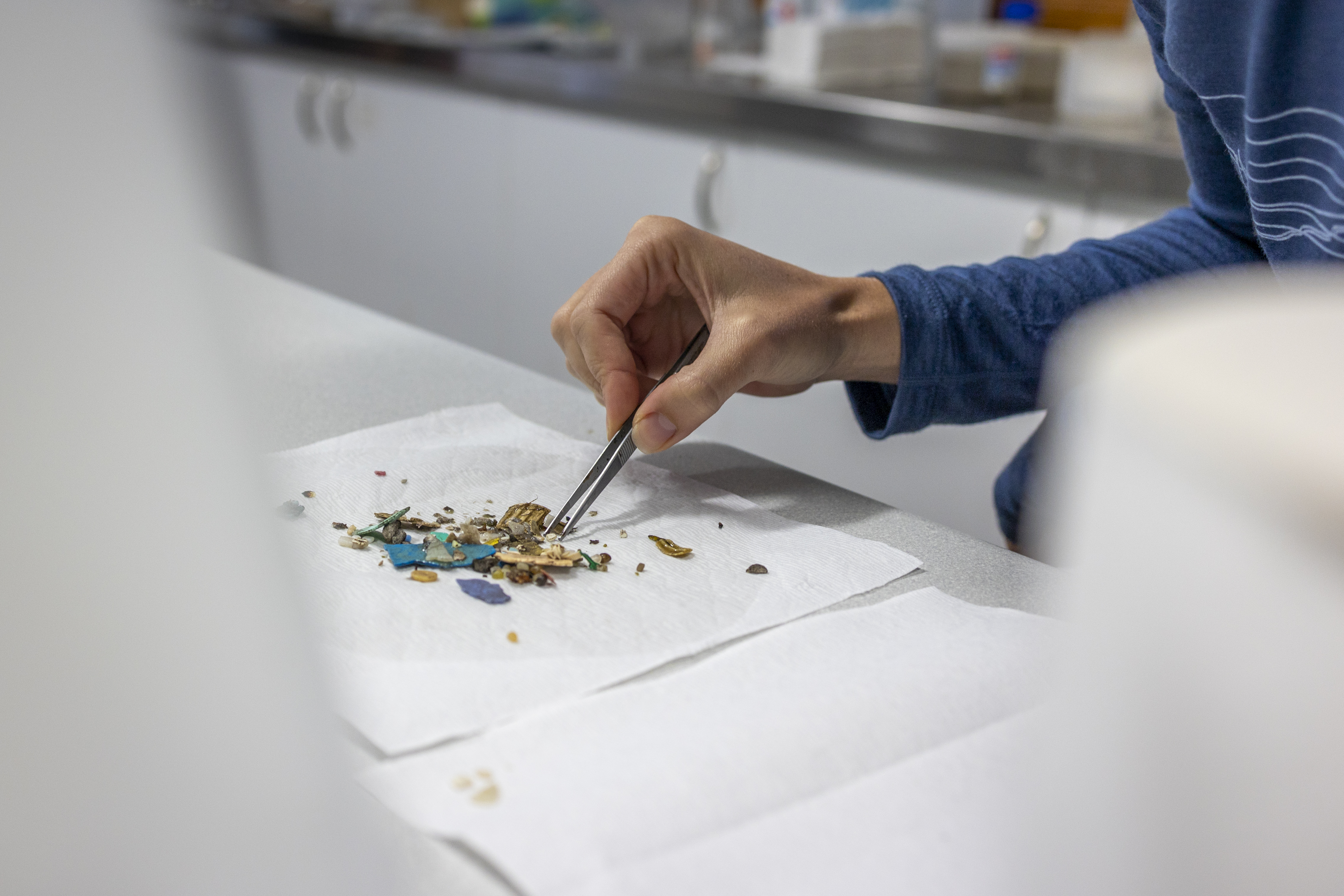
Walking along the sand, something blue catches Michelle’s eye. Crouching down, she lifts a 5 mm piece of plastic from the sand. She places it on her open palm, explaining that her time working on the beaches in Kenya taught her to spot marine plastic debris - a hard habit to unlearn.
We pause, both on our knees, scanning the thin line of pale coral fragments, sponge and twigs. I spot one - a flat, turquoise rectangle five millimetres across. I reach to pass it to Michelle, a paper cup in her hand used to hold the half dozen pieces she has already found.
We pause, both on our knees, scanning the thin line of pale coral fragments, sponge and twigs. I spot one - a flat, turquoise rectangle five millimetres across. I reach to pass it to Michelle, a paper cup in her hand used to hold the half dozen pieces she has already found.
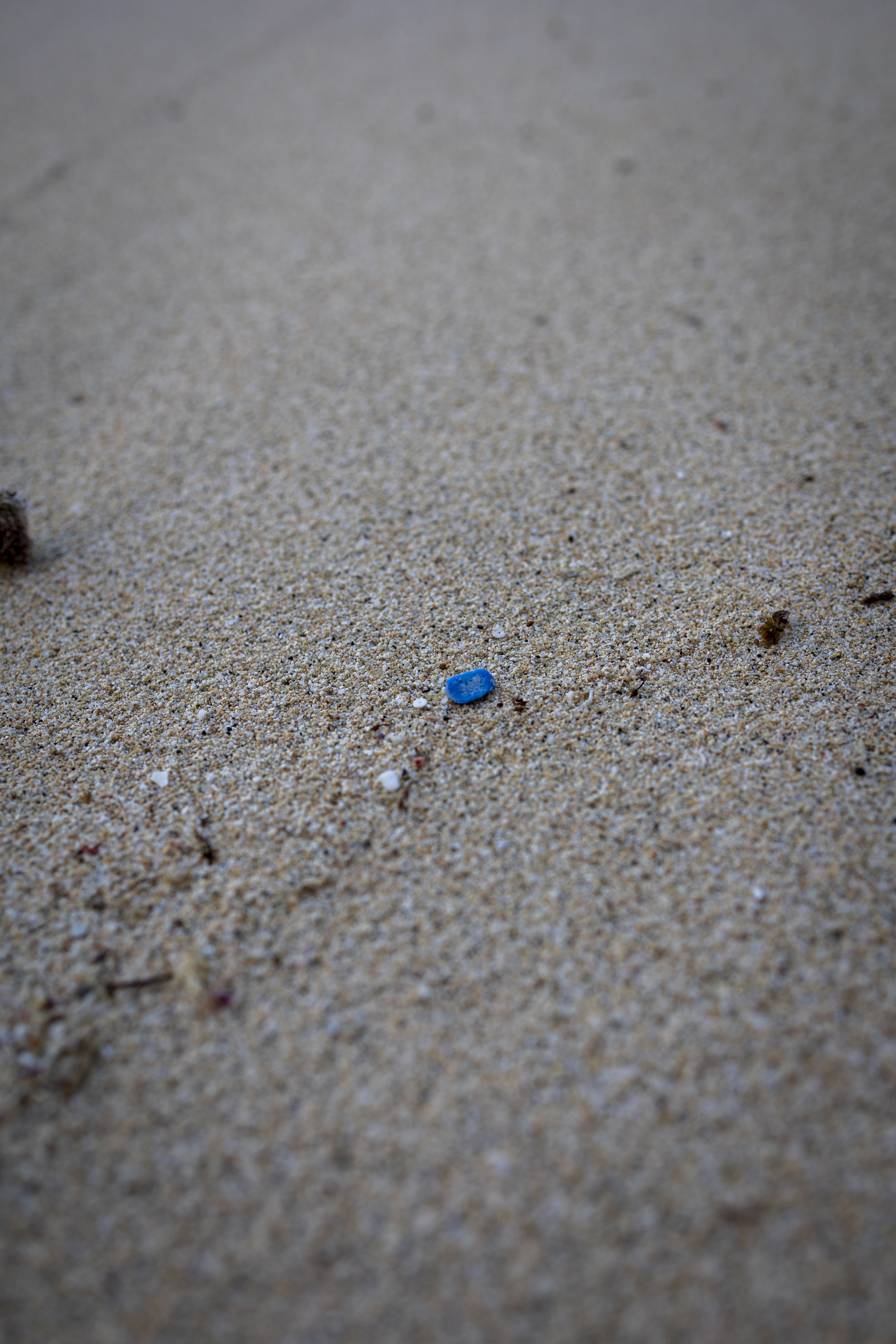
And so we carry on, inch by inch. I soon become faster at spotting colourful plastics - incongruent against the cream, oat and salmon of the sand. Michelle passes me a small, off-white, round ball about the size of a lentil. Initially I think it is a tiny, smooth drop of quartz, but something feels off - it is too light. It is a ‘nurdle’, she tells me - the building blocks of everything plastic that we use. I place it back into the paper cup, where it lightly drops next to the remains of a red bottle top - I immediately recognise that one.
We continue diligently edging along the sand, inch by inch, over ten minutes - eyes down, focused.
We continue diligently edging along the sand, inch by inch, over ten minutes - eyes down, focused.
Over the years, the Adrift research group has tried hard to hand-rear underweight chicks in an attempt to help them fledge successfully. By the time the birds leave their deep burrows, however, the growth of these tiny chicks has already been stunted for too long. Eventually, they all died.
The team necropsies all of the dead birds they find, measuring and weighing them, and extracting, counting, and weighing the plastics in their stomachs. The results are sobering. Since 2007, the team has removed more than 16 kg and 25,000 pieces of plastic from birds’ stomachs - the record from any one bird is 64 g, and 407 pieces of plastic. These are not all tiny microplastics - many are large, often the size of drink bottle tops.
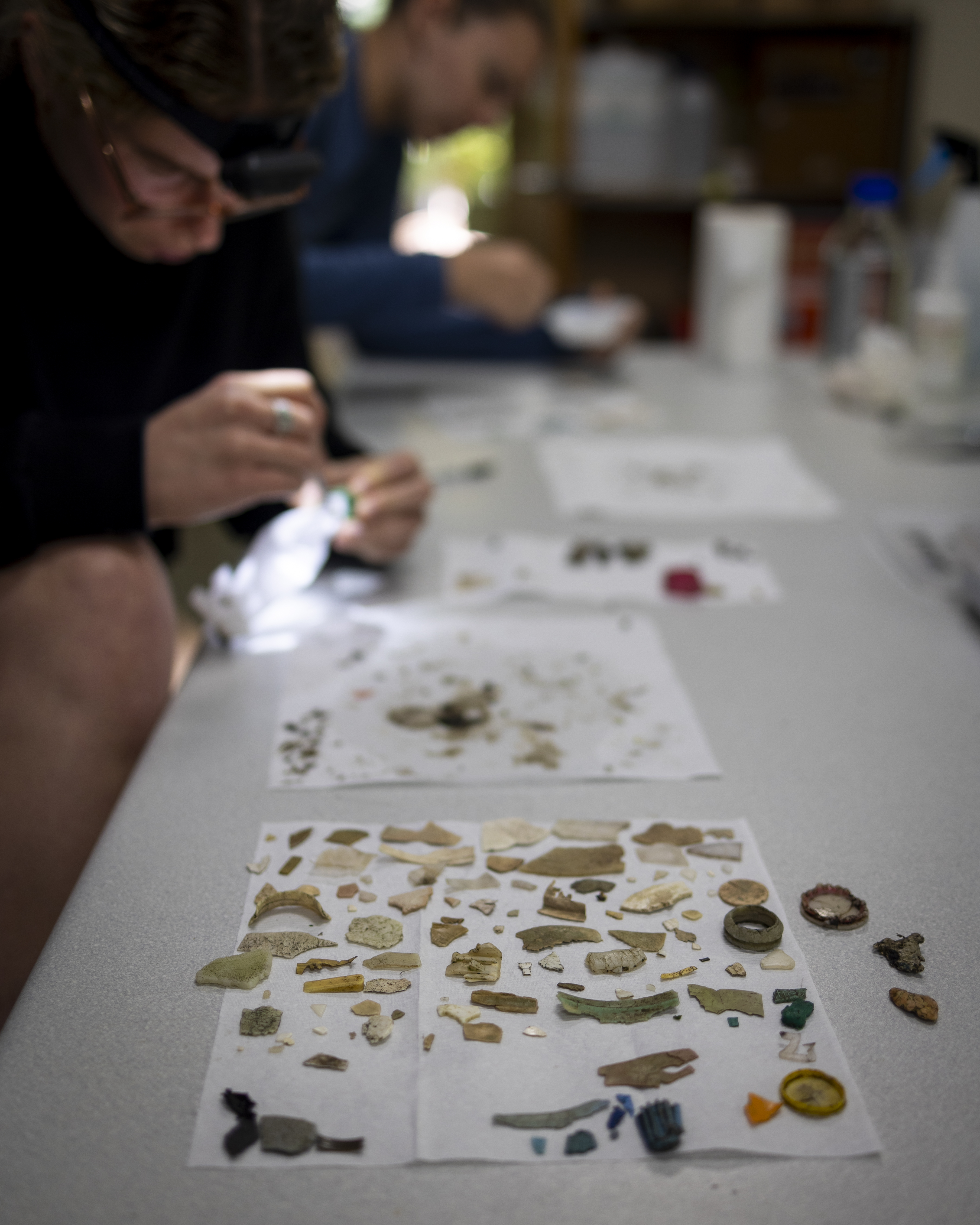
The story is not entirely bleak. Some bigger chicks can be helped. The research team spends hours in the colonies at night during fledging season, picking up the fearless chicks (they have no natural predators on the island after the eradication of rats) and gently probing their stomachs for signs of plastic. They ‘lavage’ the birds, carefully pumping their stomachs with water to induce vomiting. This can help healthy birds eject the plastics that would otherwise slowly starve them as they try to feed in the wild. For many other birds, though, the volume of plastic ingested was too great for too long.
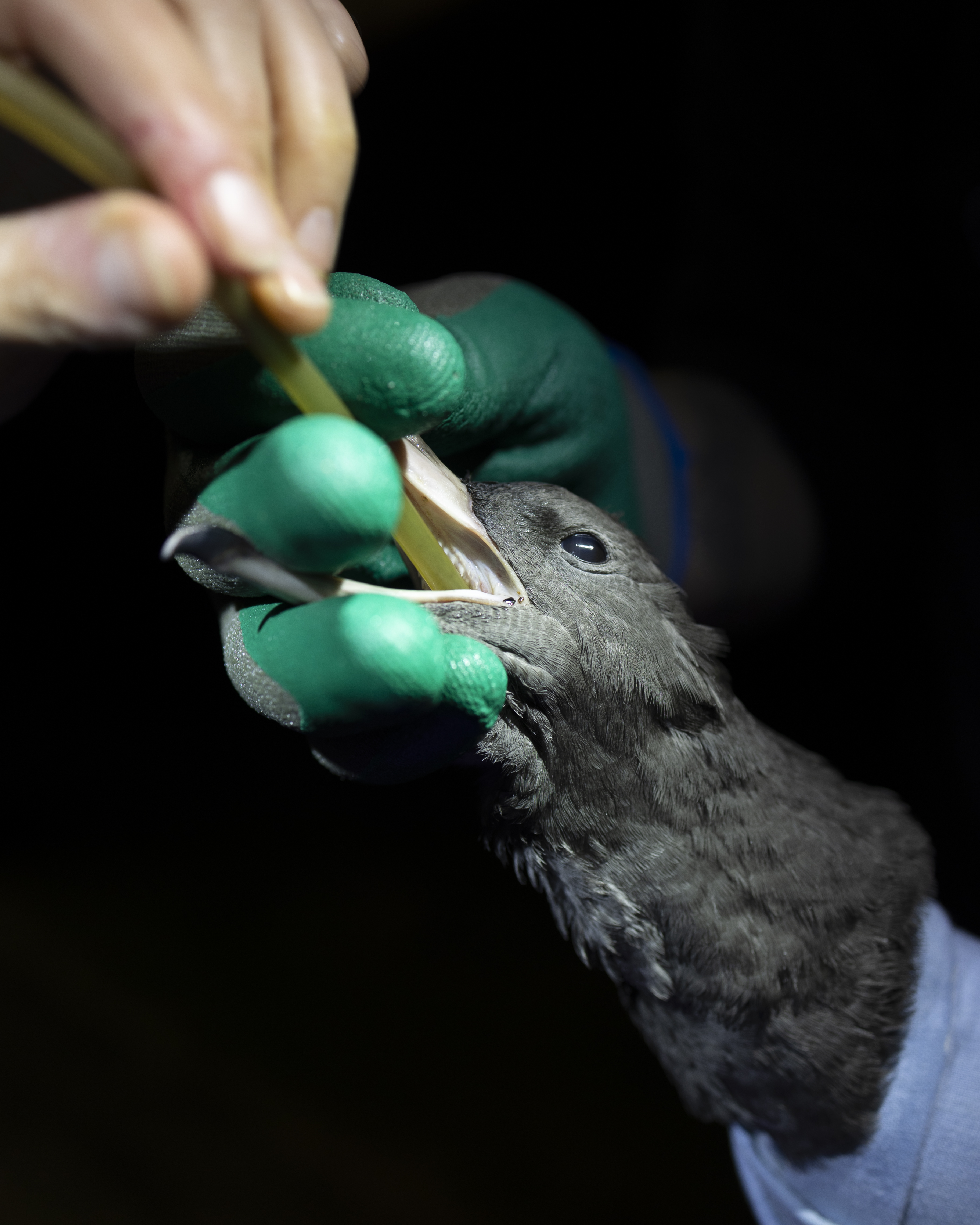

After ten minutes, we stand up, look around, my knees creak.
“Oh no, Neal - look!”, Michelle calls.
Horrified, I see less than 50 cm away the corpse of a chick, drowned whilst trying to fledge, washed back ashore during the night. Immediately, we see the cause of death. A crab has beaten us to it, opening a small hole in the bird’s abdomen. Mutli-coloured plastic spills out, its stomach full.
“Oh no, Neal - look!”, Michelle calls.
Horrified, I see less than 50 cm away the corpse of a chick, drowned whilst trying to fledge, washed back ashore during the night. Immediately, we see the cause of death. A crab has beaten us to it, opening a small hole in the bird’s abdomen. Mutli-coloured plastic spills out, its stomach full.

We pause, shamed that we have spent so long focused so intently on the tideline plastic. Engrossed in the academic detail of collating a handful of debris over a tiny, inconsequential fraction of the beach, we almost missed this chick. We can tell that it probably suffered for some time - starvation causing it to leave its burrow before it had properly developed. The feathers on its tiny wings are soaked from the sea, its body covered in sand as it bounced around in the crashing waves.
The emotional toll of the preceding days boils over and we begin to cry. I cry at the helplessness and lack of progress that a career in environmental science promised me. I cry at the total lack of pristine wilderness on the planet, every inch exposed to our chemical and physical abuse. I cry at the innocence of a being who never stood a chance of survival in the face of unchecked capitalism and economic growth. As the tears subside, we delicately lift the chick into a bag, careful not to lose any of its previous meals - important data.
“Ecological anxiety” is a phrase that is increasingly common in the news, psychological research, and amongst those who experience it. First coined by the Australian philosopher Glenn Albrecht to mean “a chronic fear of environmental doom”, it is often used alongside “ecological grief” - a much older term introduced by Aldo Leopold in the 1940s. Whatever the term, the concept is not new.
As with climate anxiety, use of the phrase “ecological anxiety” is seen by some as a pathologising or medicalisation of a very understandable human reaction to the ongoing destruction of our only home. “Ecological grief”, on the other hand, implicitly recognises that this phenomenon is an ongoing experience in proportion to the loss felt. Grieving, though painful, is also a reminder of a deep love for what we have lost, and also an opportunity to make the human connections that we intrinsically crave in dark times.
Members of the Adrift lab feel ecological grief keenly. They have seen first hand the impacts of a global, exponentially worsening problem. Sable shearwaters are not eating plastics discarded into the sea from Lord Howe Island. The plastics they consume have often travelled across the Pacific Ocean - they have been in the environment for years, if not decades. Whilst on Lord Howe, I watch Alex Bond pull a 2 cm long balloon clip from a dead chick’s stomach carrying the words ‘Mr Gaspo’. The brand operated in Australia from 1975 to 1980. The sharp-edged chunk of plastic may have been in the sea for almost 50 years before ending up inside that animal. We wondered how many other animals it had ripped through before finding its way to land.
As with climate anxiety, use of the phrase “ecological anxiety” is seen by some as a pathologising or medicalisation of a very understandable human reaction to the ongoing destruction of our only home. “Ecological grief”, on the other hand, implicitly recognises that this phenomenon is an ongoing experience in proportion to the loss felt. Grieving, though painful, is also a reminder of a deep love for what we have lost, and also an opportunity to make the human connections that we intrinsically crave in dark times.
Members of the Adrift lab feel ecological grief keenly. They have seen first hand the impacts of a global, exponentially worsening problem. Sable shearwaters are not eating plastics discarded into the sea from Lord Howe Island. The plastics they consume have often travelled across the Pacific Ocean - they have been in the environment for years, if not decades. Whilst on Lord Howe, I watch Alex Bond pull a 2 cm long balloon clip from a dead chick’s stomach carrying the words ‘Mr Gaspo’. The brand operated in Australia from 1975 to 1980. The sharp-edged chunk of plastic may have been in the sea for almost 50 years before ending up inside that animal. We wondered how many other animals it had ripped through before finding its way to land.
This is a global problem with no apparent solution, and year after year, the team returns to see its effects worsen. They each deal with their grief in different ways - focusing on the beauty of the birds and the environment, taking quiet time alone, working hard to ensure the next expedition gets the much-needed funding, focusing on the exciting new results that will make everything worthwhile. As with most environmental scientists, they feel it intensely - their field season lasts just over two weeks, and their schedules leave little time for emotional processing.
We walk on as the rising sun warms our damp cheeks. This is a desperately sad moment, but one that I am glad not to have experienced alone.
Michelle suddenly stops and exclaims. My heart sinks as I assume she has spotted more suffering.
‘“Footprints!” She points. My tired eyes follow her arm. Three sets of pristine, three-toed tracks lead from just below the grassy bank and disappear into the high tide line. Three quiet reminders that, unseen, chicks had fledged during the night, taking flight over a calm sea and starting their journey north.
We stop and pause, taking photographs.
Michelle suddenly stops and exclaims. My heart sinks as I assume she has spotted more suffering.
‘“Footprints!” She points. My tired eyes follow her arm. Three sets of pristine, three-toed tracks lead from just below the grassy bank and disappear into the high tide line. Three quiet reminders that, unseen, chicks had fledged during the night, taking flight over a calm sea and starting their journey north.
We stop and pause, taking photographs.
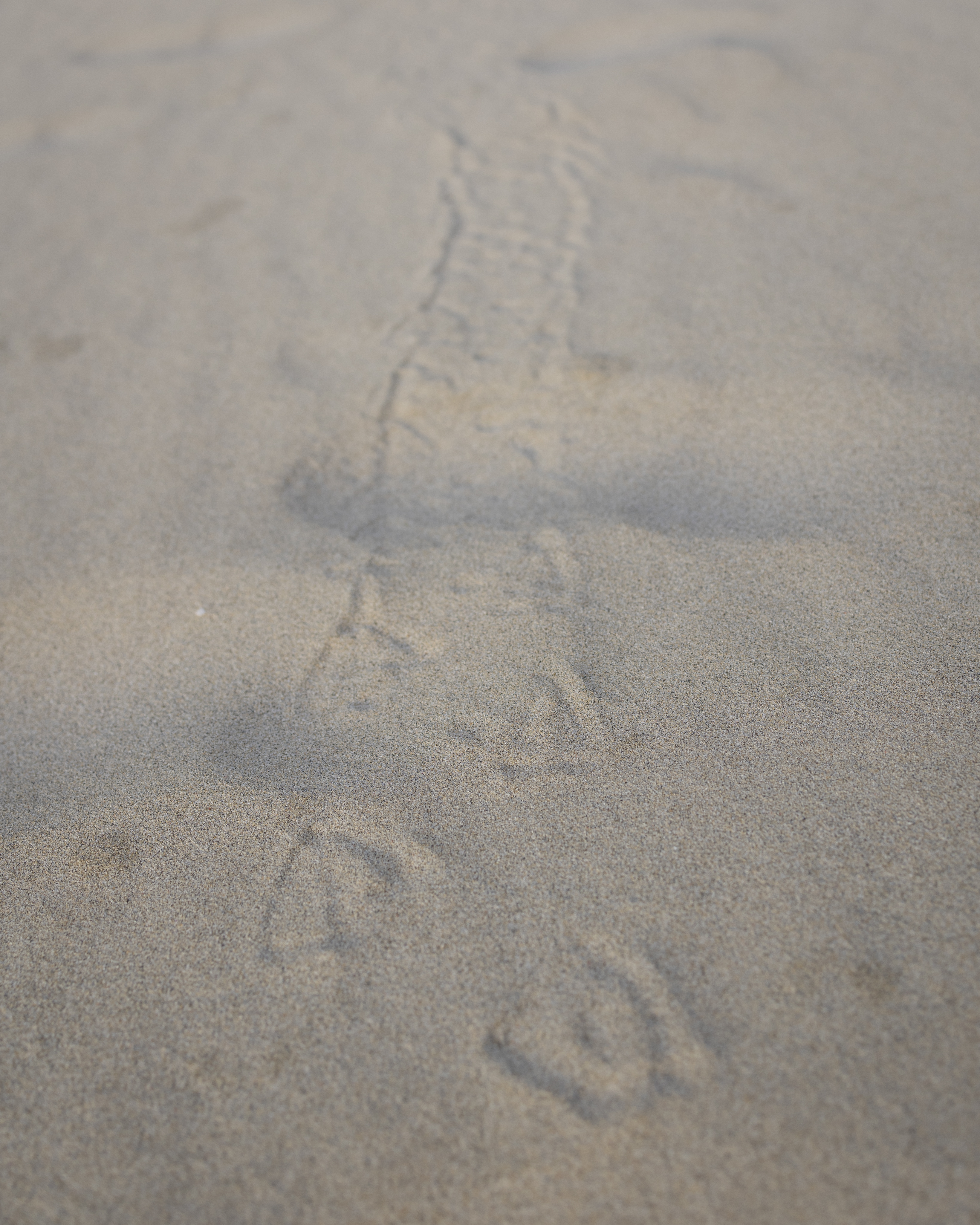
I glance up at Michelle, her eyes glistening in the morning light. “This is why we do it. We find the joy. You have to find the joy”.
As our collective awareness about the state of our planet grows, we face the knowledge of what we have lost, what I call ‘gnostalgia’ (from the Greek ‘gnosos’ meaning knowledge, and ‘algos’ meaning pain). We know things are likely to get much worse as climate change, pollution and habitat loss march on.
Scientists often do not talk about how they feel, perhaps driven by an ingrained desire to appear objective. But, talking about how we feel can be incredibly important in understanding and processing grief and in building a sense of community.
Scientists often do not talk about how they feel, perhaps driven by an ingrained desire to appear objective. But, talking about how we feel can be incredibly important in understanding and processing grief and in building a sense of community.
We must grieve for the world we have lost, whilst striving to protect what we have left. We should care for our own mental health just as we care for the environment. Our emotions can be overwhelming, particularly when our work may be the source of our pain. And so, it is vitally important that we have the resilience to work through this grief to be able to continue on our chosen paths.
At the end of my stay, the Adrift Lab group returned home to process samples, analyse data, draw conclusions. Soon enough they will return to Lord Howe Island for the next field season, but first they must restart the gruelling task of desperately collecting the modest funds needed to return and continue. Despite the knowledge that what they will observe in the coming years will get far worse, they are committed to helping the birds and highlighting their struggles.
At the end of my stay, the Adrift Lab group returned home to process samples, analyse data, draw conclusions. Soon enough they will return to Lord Howe Island for the next field season, but first they must restart the gruelling task of desperately collecting the modest funds needed to return and continue. Despite the knowledge that what they will observe in the coming years will get far worse, they are committed to helping the birds and highlighting their struggles.
The pain, this grief, often comes in waves - guilt and anger are its most vocal bedfellows. But there are other emotions if you listen closely - excitement, love, and joy. Grieving is a verb. It ebbs and flows like waves on a beach. We must learn to live with these waves, and know that the peaks and troughs do not last. We can still find the joy that drives our grief, and learn to live in a world of wounds. Not alone, but together.
― Neal Haddaway, June 2024